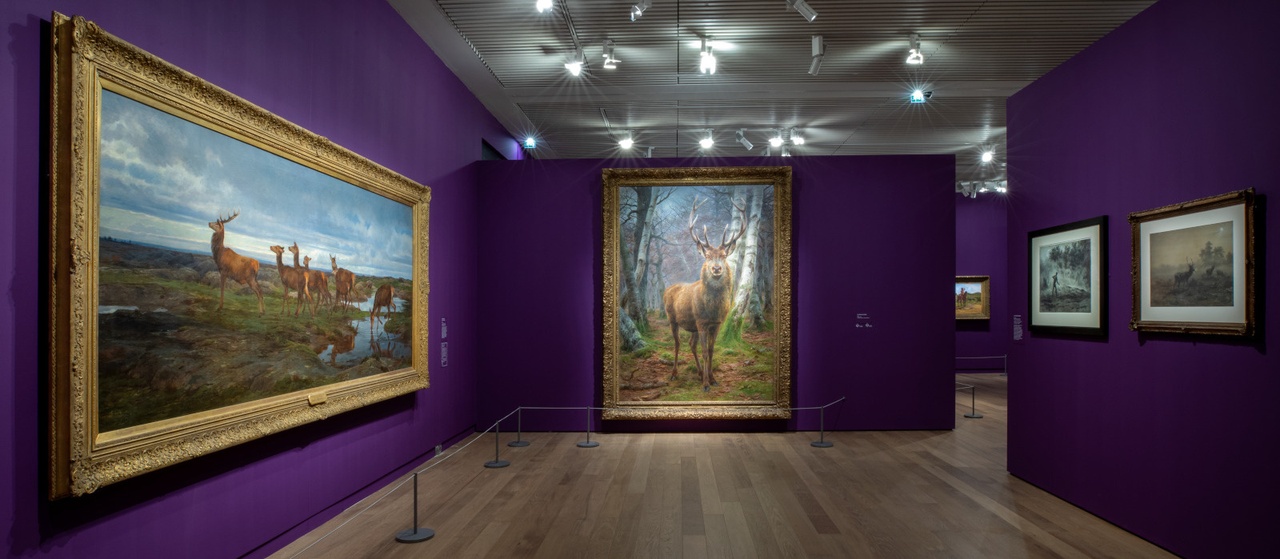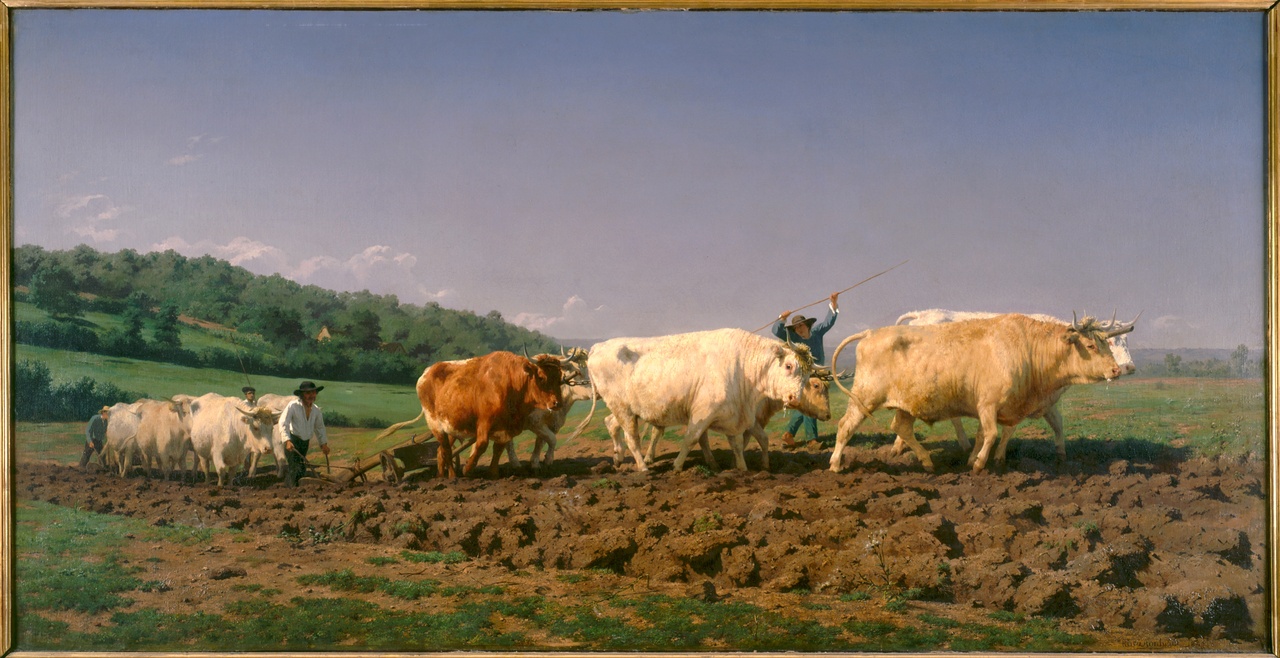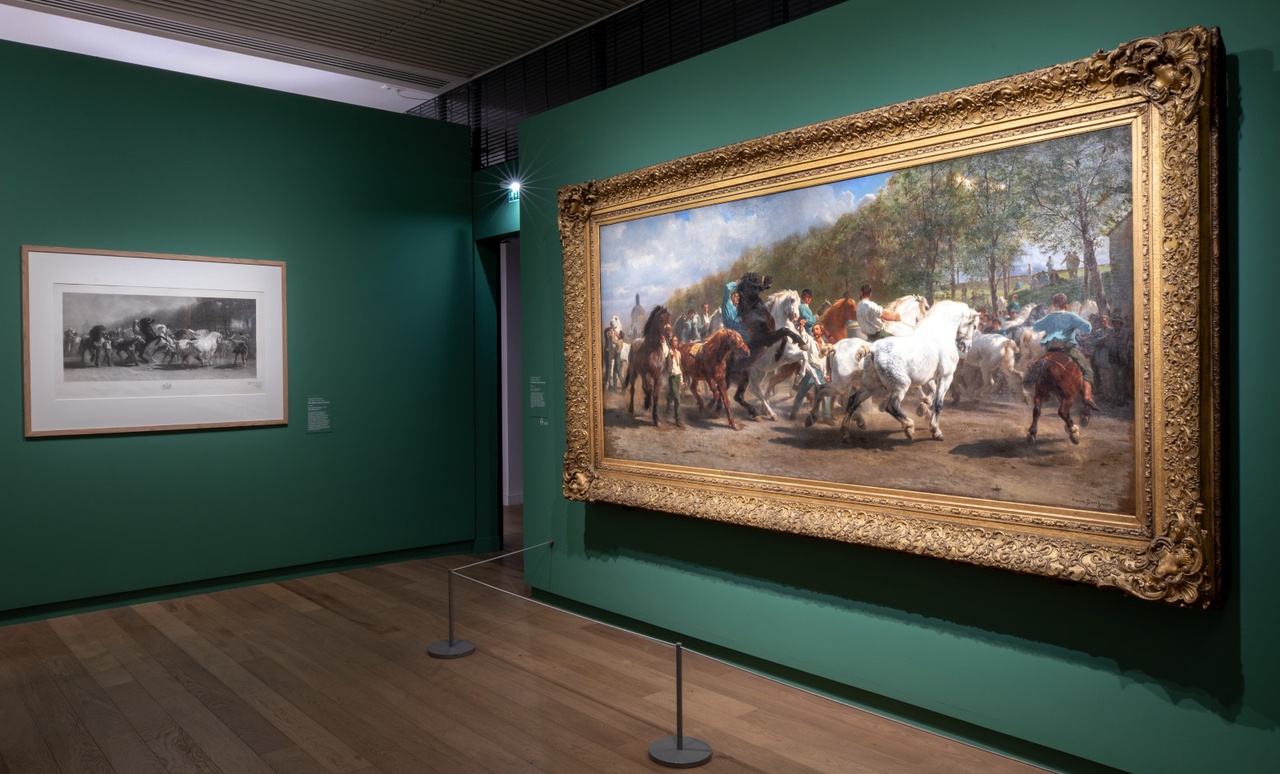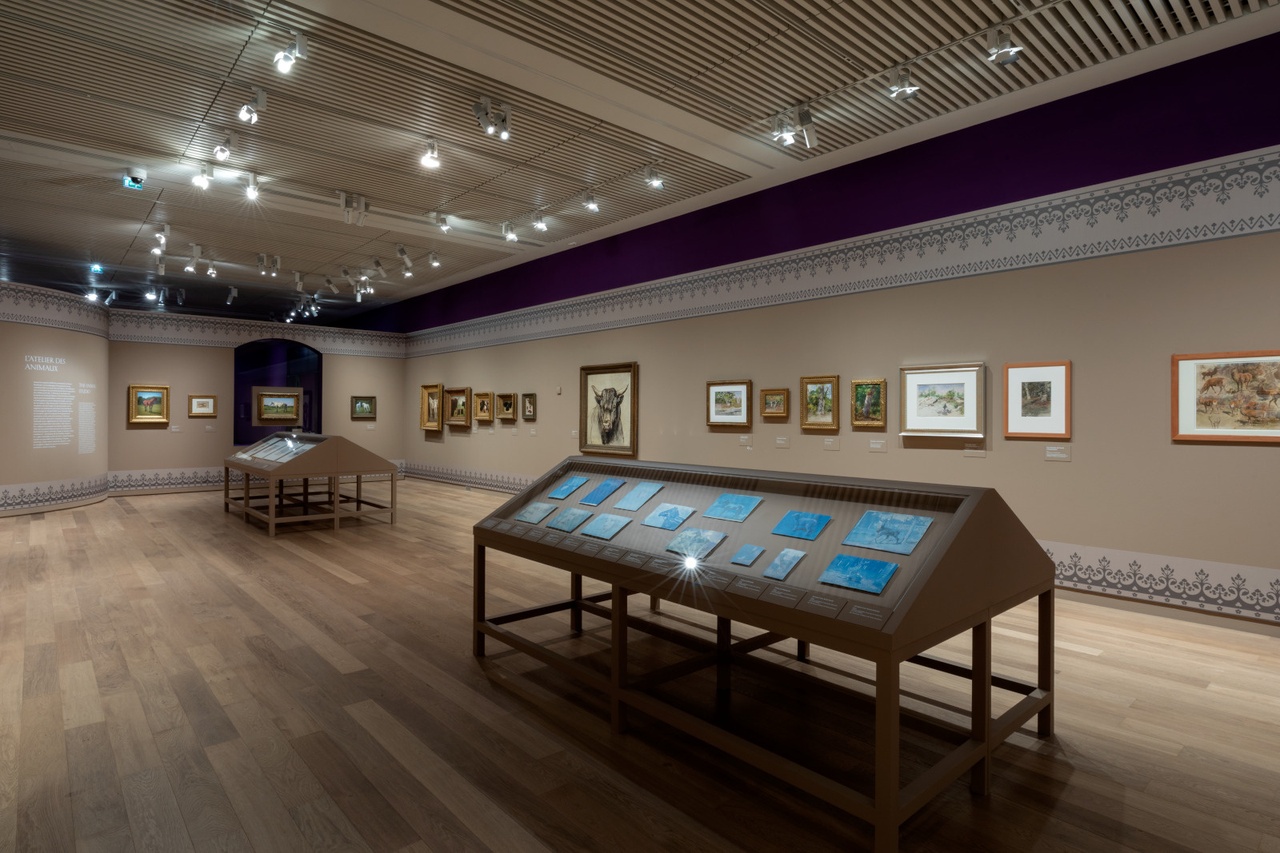ANIMAL CAMP Megan Francis Sullivan on Rosa Bonheur at the Musée d’Orsay, Paris

“Rosa Bonheur (1822–1889),” Musée d’Orsay, Paris, 2022-23, installation view
Already the streets of Paris announced the eponymous exhibition “Rosa Bonheur (1822–1899)” at the Musée d’Orsay: large posters featuring a stag with blazing eyes, startled as if a pick-up truck had suddenly appeared in the woods. Tense, poised, and slightly strabismic. Paris – Musée d’Orsay – Rosa Bonheur – let me in!
Many people seemed to share this sentiment, as the exhibition was bustling full. From the line to enter, to the crowds struggling to read wall texts or get a glimpse at the bestial renditions before them. One of the first rooms offered homage to Le Marché aux chevaux, or The Horse Fair (1853), the five-meter-long cinematic painting of muscular, frothing steeds being paraded around the Boulevard de l’Hôpital in Paris. Anyone who grew up in the tri-state area of New York, New Jersey, and Connecticut likely had this impressive image imprinted on their young brains, as the Metropolitan Museum of Art in New York is a common field-trip destination for public and private schools alike. The absence of the actual work at d’Orsay in no way lessened its presence, rather the inclusion of various copies and preparatory drawings further underlined the impact this work had at the time as a sort of painterly world-wonder. [1] Indeed, as a school child, I first encountered it at the Met; only later, as an adult artist, what seemed remarkable was not so much its size or the spumescent horses, but that Bonheur was a woman, her work featured prominently amongst other “greats” of the museum’s French 19th-century painting galleries: Jean-Baptiste-Camille Corot, Gustave Courbet, Eugène Delacroix, Horace Vernet. Who is this lady, I recall thinking in my early thirties, the same age she created the epic piece. What else did she do?
The d’Orsay exhibition addressed precisely this query, elaborating on Bonheur’s expansive oeuvre. It opened with earlier works like Deux lapins (1840), which marked her debut in the Paris Salon of 1841 at age 19, and Labourage nivernais (1849), a large landscape scene of laboring oxen that was commissioned by the French state. In further rooms appeared a large-scale charcoal drawing of cattle crossing a river Taureaux traversant un lac à Ballachulish (1867–1873), a vitrine of desktop-size bronze figurines, a delicately rendered boat full of sheep Changement de pâturages, dit aussi Une barque (1863), or a bluntly drawn bull’s head Portrait de taureau, esquisse (1857). If her early paintings can be stylistically tied with the Barbizon school, after the international success of The Horse Fair, Bonheur’s work became less directed to a salon audience and thereby also harder to place. Fluffy sheep, expressive goats, foxes that look out of birthday cards, noble lions, enigmatic portraits of dogs, flat cerulean skies. It is possible to feel frustrated by an inconsistent quality of Bonheur’s work, which only occasionally could be called “exquisite.” As a viewer I felt like on a seesaw: Is this bad? Is this good? It doesn’t matter – I love it!

Rosa Bonheur, “Labourage nivernais,” 1849
The show abounded with guilty pleasures, like Toutou, le bien aimé (1885), a terrier with a slightly sleezy grin (one Cologne artist quipped, “the Mona Lisa of dogs” [2] ). Personal favorites included El Cid, Tête de lion (1879), a large, heavily-painted lion head that resembles a postcard from the zoo. Or with Barbaro après la chasse (1858), a hunting hound looking insulted after his bath, I couldn’t help to think of the then-prevalent motif of passively observed bathing ladies, as painted by contemporaries like Delacroix. Could this have been a response?
Structurally, the exhibition at d’Orsay wove the biographical specificity of the artist together with the emergence and development of her work. Her father was an artist and Saint-Simonian. Her mother passed at an early age, leaving the free-spirited and ambitious Oscar-Raymond in charge of Rosa and her siblings, who were also rather well-respected artists in their day. As a youth, Rosa Bonheur was a tomboy who preferred the barn and artist studio to more “feminine” environs. [3] The Bonheurs hung around with prominent artists and cultural figures, so also knew the ins and outs of the Parisian art world – the salon, the dealers, the buyers, the critics. [4]
Animal portraiture and landscape scenes were established genres in mid-19th-century European painting, a niche Rosa Bonheur could capitalize on. Her work was both celebrated and hotly criticized in art journals like L’Artiste. In a discussion of the 1853 Salon, where Le Marché aux chevaux had its premiere, critic Louis Clément de Ris decried her popular success, stating that in more educated views, Bonheur’s painting would not hold a candle to contemporaries of the animal or landscape genre like Constant Troyon or Achille Giroux. Still, he complimented its overall composition and effect. [5] Perhaps his assessment was not without merit: “It is to be feared that the success of Mademoiselle Bonheur with a certain portion of the public will be fatal to her, and that she will be more sensitive to the quantity than to the quality of the praises.” [6] Yet it seems precisely the popular success of Bonheur to be what gave wings for her to emerge as an eccentric and long-lasting figure of art history.

“Rosa Bonheur (1822–1889),” Musée d’Orsay, Paris, 2022-23, installation view
It is noteworthy that many works in the exhibition are owned by US museums, underlining not only her international reception but also an economic foothold that perhaps made her less susceptible to the criticisms of the Paris elite. [7] One room in the d’Orsay show was dedicated to her atelier and work life. Having purchased a chalet outside of Paris, she was surrounded by a wild menagerie of animals. Her closest companions, first Nathalie Micas and later Anne Klumpke, played major roles in Bonheur’s existence, multi-tasking as assistants, archivists, biographers, and presumably lovers.
Truly fascinating was the exhibition’s inclusion of cyanotypes that had been worked on with gouache and pencil by the artist, confirming an intuition that many of her works had photographic references.
In a far corner toward the exit hung another darling, framed by the backdrop of a purple wall: Colonel William F. Cody (1889). Bonheur never set foot in America, but made acquaintance with the flamboyant frontiersman, also known as Buffalo Bill, while his show Buffalo Bill’s Wild West was in Paris in the 1890s, and they soon became friends. Buffalo Bill was himself a figure that could emerge only out of the tectonic shifts in economy, technology, and culture of the later 19th century. Working as an active soldier, hunter, and guide in the American West, he was also involved in the developing show business, taking recently captured buffalo and employing dispossessed Native Americans in a circus-like show that toured throughout the United States and Europe. Bonheur is featured in one of the Wild West lithographs, seated at a field easel and captioned “Art Perpetuating Fame.”

“Rosa Bonheur (1822–1889),” Musée d’Orsay, Paris, 2022-23, installation view
Some aspects of the exhibition, like the fun facts about animals integrated amongst the displays, or the provision of paper and magic markers for visitors to draw along with, aimed clearly at a target group of pre-teens or forever-youngs. [8] Also, in proclaiming the great virtuosity of Bonheur’s works, as the exhibition text does, some more complex questions about her artistic contribution get blurred over. In my opinion, there is a sort of unfulfillment of a pre-modern artistic mastery – some works could be easily passed over in a flea market – that opens up a chance to situate why Bonheur was indeed such an interesting and modern figure. What is often described as her empathy to animals evident in their focal position throughout her oeuvre could also be regarded as a practice in transferred subjectivity. In considering the relation of her singular and eccentric lifestyle to her work, the potentials of fame and new markets recalibrated certain long-held guidelines and brought to light a performed identity of master artist that could brush upon “camp.” Beyond Rosa Bonheur being a deservedly celebrated female artist, these complexities in her work seem to be aspects that make it so vital today.
“Rosa Bonheur (1822–1889),” Musée des Beaux-Arts de Bordeaux, May 18–September 18, 2022; Musée d’Orsay, Paris, October 18, 2022–January 15, 2023.
Megan Francis Sullivan is an artist living in Berlin.
Image credit: 1, 3, 4: © Musée d’Orsay, Paris, photo Sophy Crépy; 2. © Courtesy Musée d'Orsay, Dist. RMN-Grand Palais, photo Patrice Schmidt
Notes
| [1] | After receiving almost sensational press attention at the Salon, The Horse Fair was later purchased by dealer Ernest Gambart and put on a two-year traveling tour in the UK, including a stop at Buckingham Palace for Queen Victoria. See, for example: Catherine Hewitt, Art Is a Tyrant (London: Icon Books, 2020), 149–61. |
| [2] | See @slothlobster, October 20, 2022, Instagram. |
| [3] | For an incredibly researched account of Bonheur’s biography, see Dore Ashton, Rosa Bonheur: A Life and a Legend, with illustrations and captions by Denise Brown Hare (London: Secker & Warburg, 1981). |
| [4] | See also the exhibition catalogue Rosa Bonheur et Sa Famille – Trois générations d’artistes (Paris: Reunion Des Musees Nationaux, 2017). |
| [5] | See: L’Artiste: journal de la littérature et des beaux-arts (Paris, January 1, 1853), Ser5/T10, online. |
| [6] | Ibid. Author’s translation. |
| [7] | In 1855 Bonheur “stops submitting paintings to the Salon as: ‘such was the enthusiasm of Monsieur Gambart and the Tedescos that they could barely wait for my works to be finished before shipping them off to England and especially America.’” (From the exhibition brochure.) |
| [8] | I wondered how this same device might work in the neighboring show‚ “Edvard Munch: A Poem of Life, Love and Death.” |
